Evaluating Government Strategies: Tuberculosis Among Ethnic Minorities
VerifiedAdded on 2023/06/11
|24
|9742
|293
Report
AI Summary
This report assesses the impact of government strategies in tackling tuberculosis (TB) among ethnic minorities in England. It begins by outlining the background of TB, its disproportionate impact on ethnic minorities due to factors like limited healthcare access and socioeconomic conditions, and the government's collaborative Tuberculosis Strategy for England 2015-2020. The methodology section details the use of secondary data collected from sources like Google Scholar and the District Health Information Management System. The literature review examines the effectiveness of governmental policies, steps needed for further TB reduction, and the impact of the COVID-19 pandemic on TB control efforts. Findings suggest that government strategies have been effective, though hampered by the pandemic. The report concludes that sustained government efforts have yielded positive results in reducing TB cases among ethnic minorities and offers recommendations for continued improvement. Desklib provides access to similar reports and study tools for students.
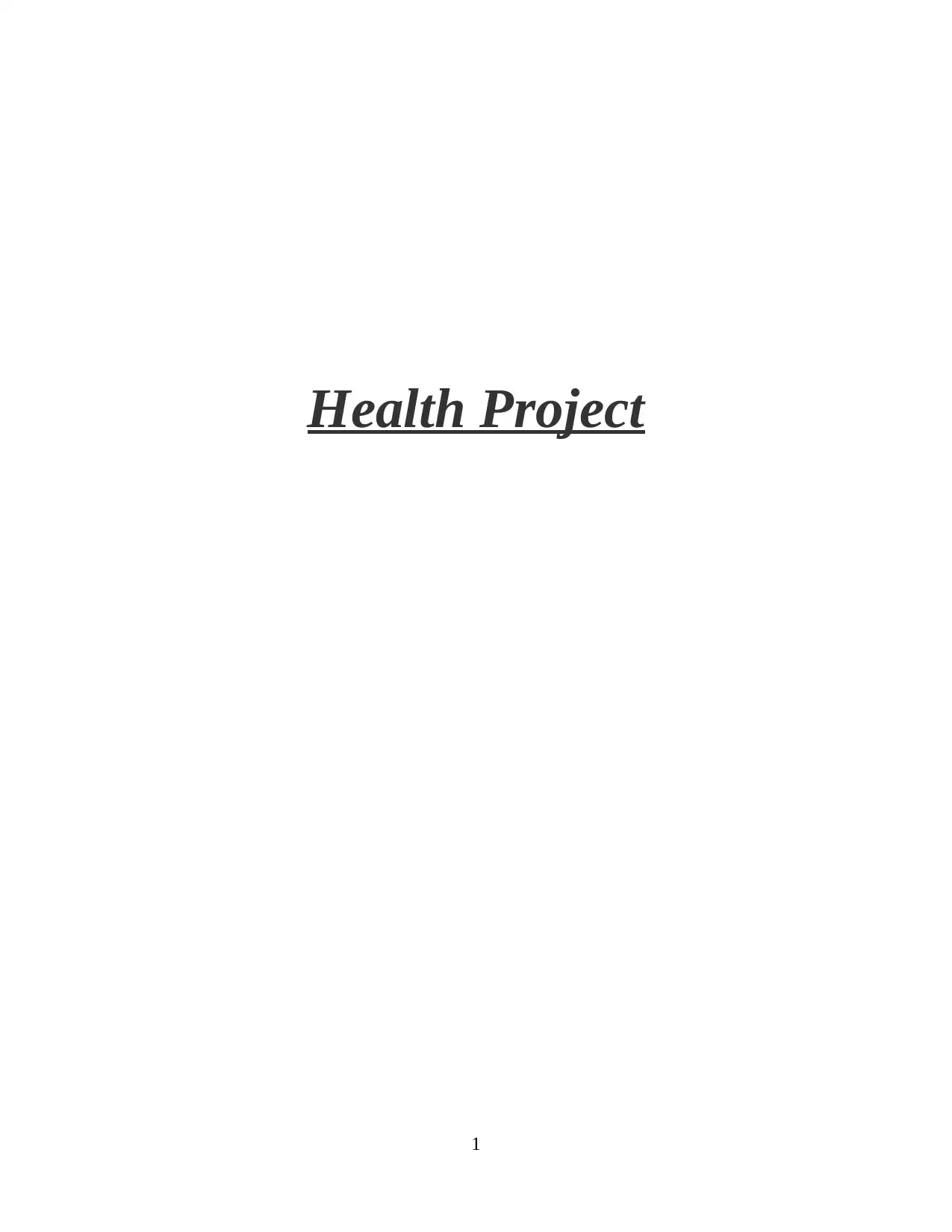
Health Project
1
1
Paraphrase This Document
Need a fresh take? Get an instant paraphrase of this document with our AI Paraphraser
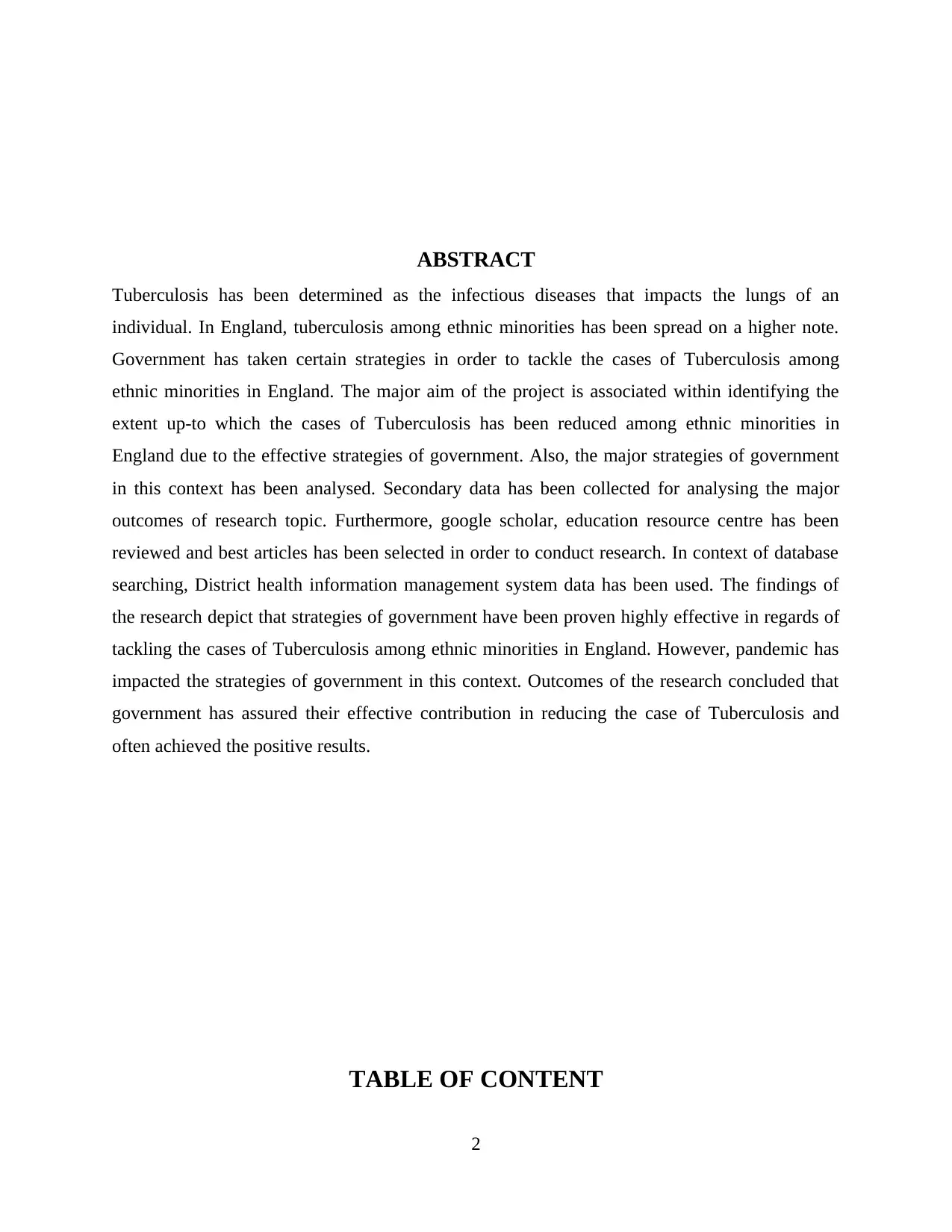
ABSTRACT
Tuberculosis has been determined as the infectious diseases that impacts the lungs of an
individual. In England, tuberculosis among ethnic minorities has been spread on a higher note.
Government has taken certain strategies in order to tackle the cases of Tuberculosis among
ethnic minorities in England. The major aim of the project is associated within identifying the
extent up-to which the cases of Tuberculosis has been reduced among ethnic minorities in
England due to the effective strategies of government. Also, the major strategies of government
in this context has been analysed. Secondary data has been collected for analysing the major
outcomes of research topic. Furthermore, google scholar, education resource centre has been
reviewed and best articles has been selected in order to conduct research. In context of database
searching, District health information management system data has been used. The findings of
the research depict that strategies of government have been proven highly effective in regards of
tackling the cases of Tuberculosis among ethnic minorities in England. However, pandemic has
impacted the strategies of government in this context. Outcomes of the research concluded that
government has assured their effective contribution in reducing the case of Tuberculosis and
often achieved the positive results.
TABLE OF CONTENT
2
Tuberculosis has been determined as the infectious diseases that impacts the lungs of an
individual. In England, tuberculosis among ethnic minorities has been spread on a higher note.
Government has taken certain strategies in order to tackle the cases of Tuberculosis among
ethnic minorities in England. The major aim of the project is associated within identifying the
extent up-to which the cases of Tuberculosis has been reduced among ethnic minorities in
England due to the effective strategies of government. Also, the major strategies of government
in this context has been analysed. Secondary data has been collected for analysing the major
outcomes of research topic. Furthermore, google scholar, education resource centre has been
reviewed and best articles has been selected in order to conduct research. In context of database
searching, District health information management system data has been used. The findings of
the research depict that strategies of government have been proven highly effective in regards of
tackling the cases of Tuberculosis among ethnic minorities in England. However, pandemic has
impacted the strategies of government in this context. Outcomes of the research concluded that
government has assured their effective contribution in reducing the case of Tuberculosis and
often achieved the positive results.
TABLE OF CONTENT
2
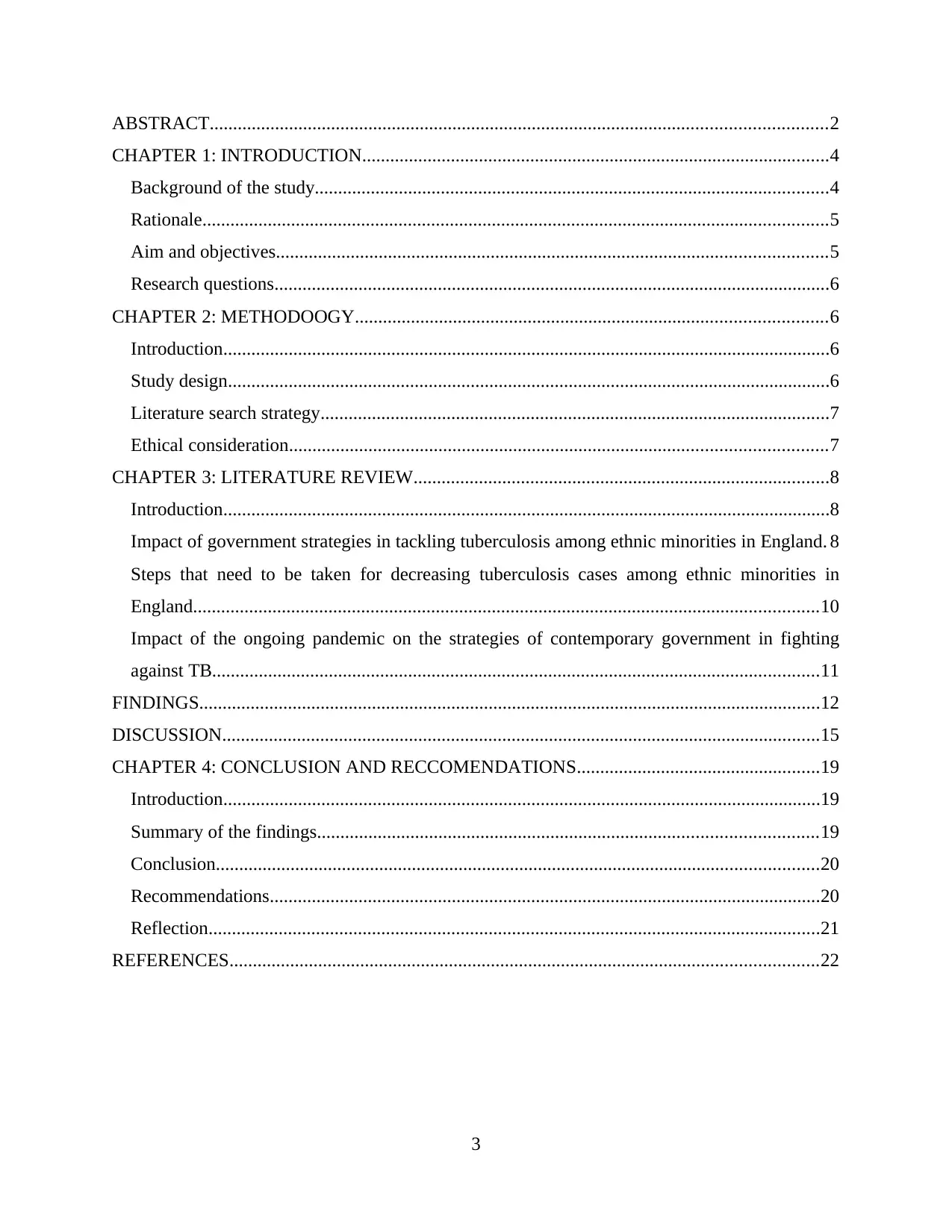
ABSTRACT....................................................................................................................................2
CHAPTER 1: INTRODUCTION....................................................................................................4
Background of the study..............................................................................................................4
Rationale......................................................................................................................................5
Aim and objectives......................................................................................................................5
Research questions.......................................................................................................................6
CHAPTER 2: METHODOOGY.....................................................................................................6
Introduction..................................................................................................................................6
Study design.................................................................................................................................6
Literature search strategy.............................................................................................................7
Ethical consideration...................................................................................................................7
CHAPTER 3: LITERATURE REVIEW.........................................................................................8
Introduction..................................................................................................................................8
Impact of government strategies in tackling tuberculosis among ethnic minorities in England. 8
Steps that need to be taken for decreasing tuberculosis cases among ethnic minorities in
England......................................................................................................................................10
Impact of the ongoing pandemic on the strategies of contemporary government in fighting
against TB..................................................................................................................................11
FINDINGS.....................................................................................................................................12
DISCUSSION................................................................................................................................15
CHAPTER 4: CONCLUSION AND RECCOMENDATIONS....................................................19
Introduction................................................................................................................................19
Summary of the findings...........................................................................................................19
Conclusion.................................................................................................................................20
Recommendations......................................................................................................................20
Reflection...................................................................................................................................21
REFERENCES..............................................................................................................................22
3
CHAPTER 1: INTRODUCTION....................................................................................................4
Background of the study..............................................................................................................4
Rationale......................................................................................................................................5
Aim and objectives......................................................................................................................5
Research questions.......................................................................................................................6
CHAPTER 2: METHODOOGY.....................................................................................................6
Introduction..................................................................................................................................6
Study design.................................................................................................................................6
Literature search strategy.............................................................................................................7
Ethical consideration...................................................................................................................7
CHAPTER 3: LITERATURE REVIEW.........................................................................................8
Introduction..................................................................................................................................8
Impact of government strategies in tackling tuberculosis among ethnic minorities in England. 8
Steps that need to be taken for decreasing tuberculosis cases among ethnic minorities in
England......................................................................................................................................10
Impact of the ongoing pandemic on the strategies of contemporary government in fighting
against TB..................................................................................................................................11
FINDINGS.....................................................................................................................................12
DISCUSSION................................................................................................................................15
CHAPTER 4: CONCLUSION AND RECCOMENDATIONS....................................................19
Introduction................................................................................................................................19
Summary of the findings...........................................................................................................19
Conclusion.................................................................................................................................20
Recommendations......................................................................................................................20
Reflection...................................................................................................................................21
REFERENCES..............................................................................................................................22
3
⊘ This is a preview!⊘
Do you want full access?
Subscribe today to unlock all pages.

Trusted by 1+ million students worldwide
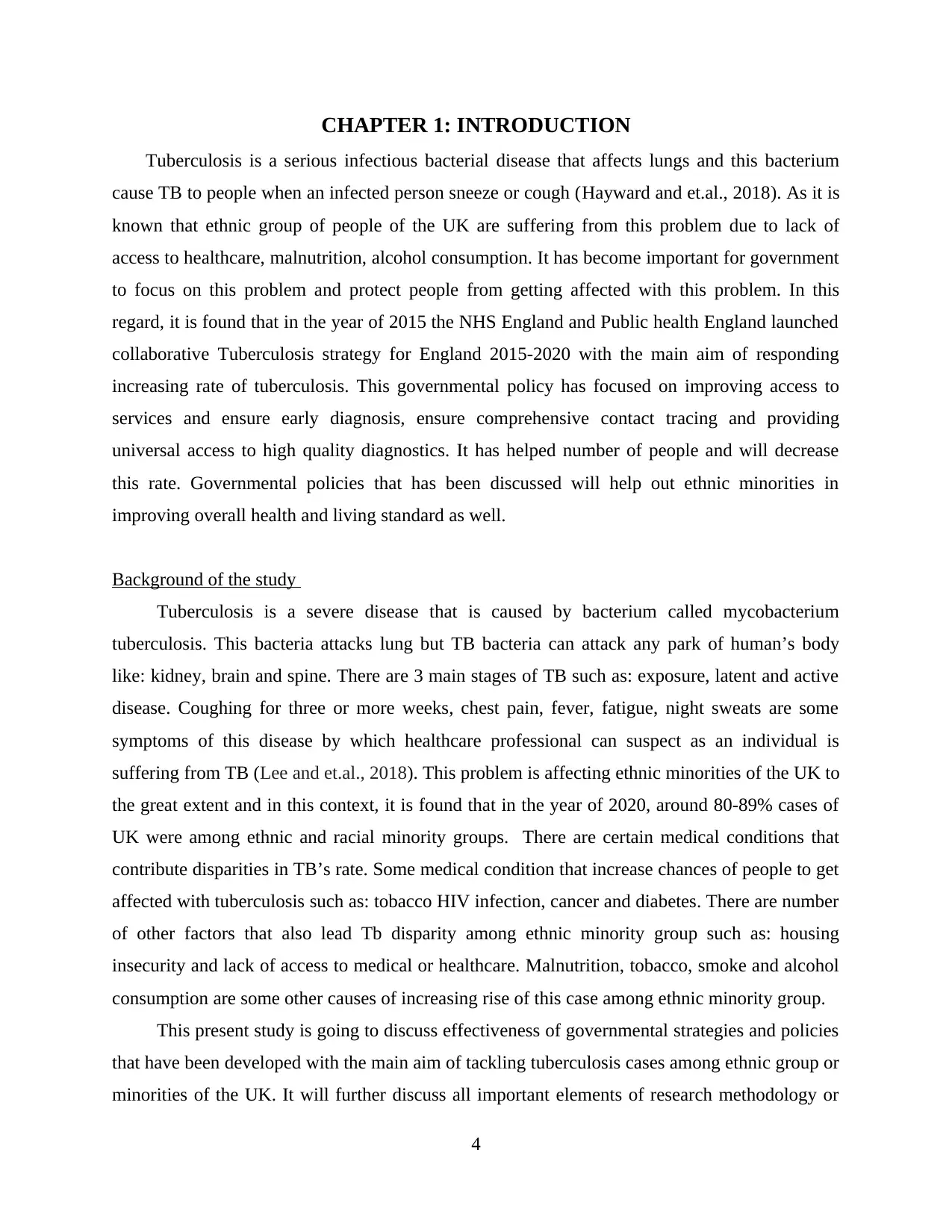
CHAPTER 1: INTRODUCTION
Tuberculosis is a serious infectious bacterial disease that affects lungs and this bacterium
cause TB to people when an infected person sneeze or cough (Hayward and et.al., 2018). As it is
known that ethnic group of people of the UK are suffering from this problem due to lack of
access to healthcare, malnutrition, alcohol consumption. It has become important for government
to focus on this problem and protect people from getting affected with this problem. In this
regard, it is found that in the year of 2015 the NHS England and Public health England launched
collaborative Tuberculosis strategy for England 2015-2020 with the main aim of responding
increasing rate of tuberculosis. This governmental policy has focused on improving access to
services and ensure early diagnosis, ensure comprehensive contact tracing and providing
universal access to high quality diagnostics. It has helped number of people and will decrease
this rate. Governmental policies that has been discussed will help out ethnic minorities in
improving overall health and living standard as well.
Background of the study
Tuberculosis is a severe disease that is caused by bacterium called mycobacterium
tuberculosis. This bacteria attacks lung but TB bacteria can attack any park of human’s body
like: kidney, brain and spine. There are 3 main stages of TB such as: exposure, latent and active
disease. Coughing for three or more weeks, chest pain, fever, fatigue, night sweats are some
symptoms of this disease by which healthcare professional can suspect as an individual is
suffering from TB (Lee and et.al., 2018). This problem is affecting ethnic minorities of the UK to
the great extent and in this context, it is found that in the year of 2020, around 80-89% cases of
UK were among ethnic and racial minority groups. There are certain medical conditions that
contribute disparities in TB’s rate. Some medical condition that increase chances of people to get
affected with tuberculosis such as: tobacco HIV infection, cancer and diabetes. There are number
of other factors that also lead Tb disparity among ethnic minority group such as: housing
insecurity and lack of access to medical or healthcare. Malnutrition, tobacco, smoke and alcohol
consumption are some other causes of increasing rise of this case among ethnic minority group.
This present study is going to discuss effectiveness of governmental strategies and policies
that have been developed with the main aim of tackling tuberculosis cases among ethnic group or
minorities of the UK. It will further discuss all important elements of research methodology or
4
Tuberculosis is a serious infectious bacterial disease that affects lungs and this bacterium
cause TB to people when an infected person sneeze or cough (Hayward and et.al., 2018). As it is
known that ethnic group of people of the UK are suffering from this problem due to lack of
access to healthcare, malnutrition, alcohol consumption. It has become important for government
to focus on this problem and protect people from getting affected with this problem. In this
regard, it is found that in the year of 2015 the NHS England and Public health England launched
collaborative Tuberculosis strategy for England 2015-2020 with the main aim of responding
increasing rate of tuberculosis. This governmental policy has focused on improving access to
services and ensure early diagnosis, ensure comprehensive contact tracing and providing
universal access to high quality diagnostics. It has helped number of people and will decrease
this rate. Governmental policies that has been discussed will help out ethnic minorities in
improving overall health and living standard as well.
Background of the study
Tuberculosis is a severe disease that is caused by bacterium called mycobacterium
tuberculosis. This bacteria attacks lung but TB bacteria can attack any park of human’s body
like: kidney, brain and spine. There are 3 main stages of TB such as: exposure, latent and active
disease. Coughing for three or more weeks, chest pain, fever, fatigue, night sweats are some
symptoms of this disease by which healthcare professional can suspect as an individual is
suffering from TB (Lee and et.al., 2018). This problem is affecting ethnic minorities of the UK to
the great extent and in this context, it is found that in the year of 2020, around 80-89% cases of
UK were among ethnic and racial minority groups. There are certain medical conditions that
contribute disparities in TB’s rate. Some medical condition that increase chances of people to get
affected with tuberculosis such as: tobacco HIV infection, cancer and diabetes. There are number
of other factors that also lead Tb disparity among ethnic minority group such as: housing
insecurity and lack of access to medical or healthcare. Malnutrition, tobacco, smoke and alcohol
consumption are some other causes of increasing rise of this case among ethnic minority group.
This present study is going to discuss effectiveness of governmental strategies and policies
that have been developed with the main aim of tackling tuberculosis cases among ethnic group or
minorities of the UK. It will further discuss all important elements of research methodology or
4
Paraphrase This Document
Need a fresh take? Get an instant paraphrase of this document with our AI Paraphraser
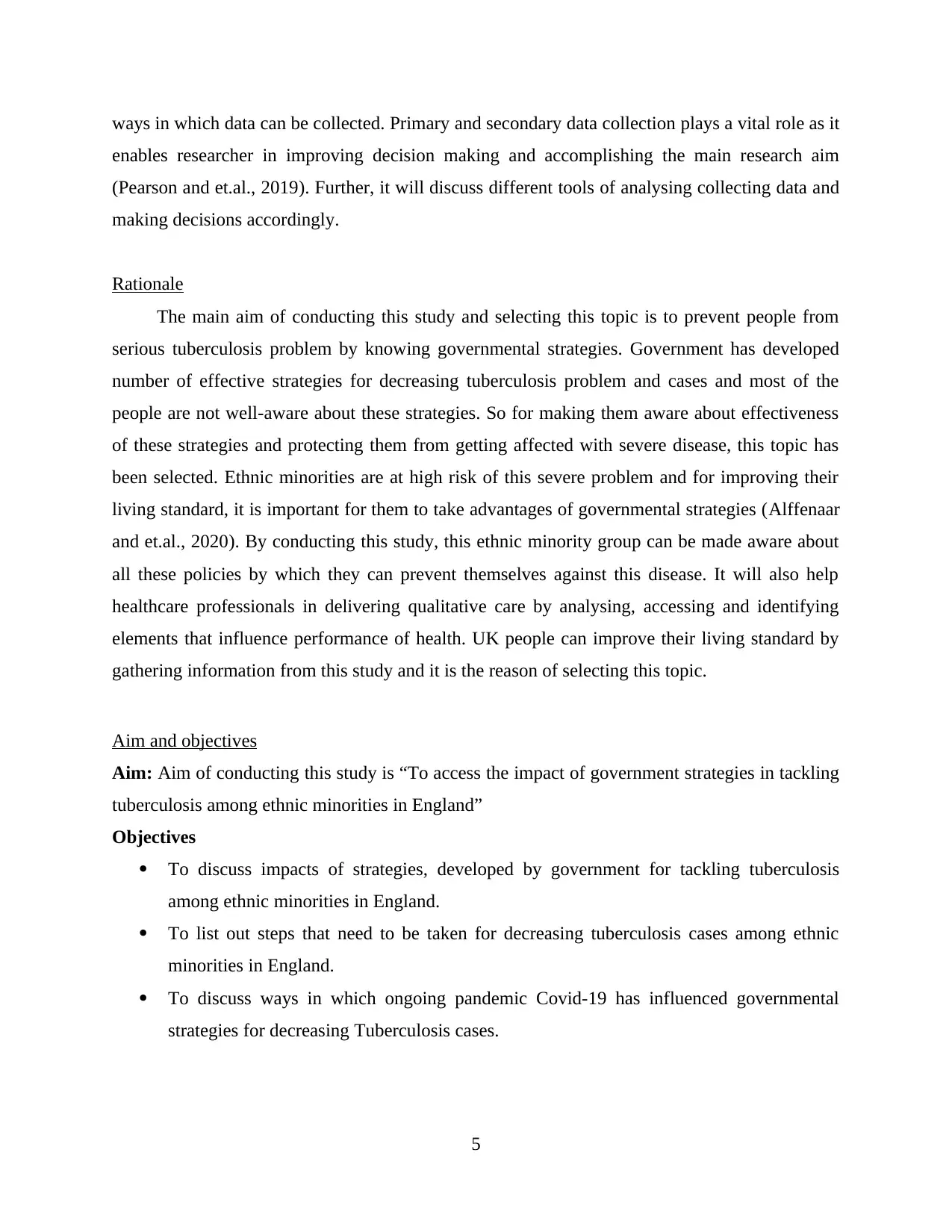
ways in which data can be collected. Primary and secondary data collection plays a vital role as it
enables researcher in improving decision making and accomplishing the main research aim
(Pearson and et.al., 2019). Further, it will discuss different tools of analysing collecting data and
making decisions accordingly.
Rationale
The main aim of conducting this study and selecting this topic is to prevent people from
serious tuberculosis problem by knowing governmental strategies. Government has developed
number of effective strategies for decreasing tuberculosis problem and cases and most of the
people are not well-aware about these strategies. So for making them aware about effectiveness
of these strategies and protecting them from getting affected with severe disease, this topic has
been selected. Ethnic minorities are at high risk of this severe problem and for improving their
living standard, it is important for them to take advantages of governmental strategies (Alffenaar
and et.al., 2020). By conducting this study, this ethnic minority group can be made aware about
all these policies by which they can prevent themselves against this disease. It will also help
healthcare professionals in delivering qualitative care by analysing, accessing and identifying
elements that influence performance of health. UK people can improve their living standard by
gathering information from this study and it is the reason of selecting this topic.
Aim and objectives
Aim: Aim of conducting this study is “To access the impact of government strategies in tackling
tuberculosis among ethnic minorities in England”
Objectives
To discuss impacts of strategies, developed by government for tackling tuberculosis
among ethnic minorities in England.
To list out steps that need to be taken for decreasing tuberculosis cases among ethnic
minorities in England.
To discuss ways in which ongoing pandemic Covid-19 has influenced governmental
strategies for decreasing Tuberculosis cases.
5
enables researcher in improving decision making and accomplishing the main research aim
(Pearson and et.al., 2019). Further, it will discuss different tools of analysing collecting data and
making decisions accordingly.
Rationale
The main aim of conducting this study and selecting this topic is to prevent people from
serious tuberculosis problem by knowing governmental strategies. Government has developed
number of effective strategies for decreasing tuberculosis problem and cases and most of the
people are not well-aware about these strategies. So for making them aware about effectiveness
of these strategies and protecting them from getting affected with severe disease, this topic has
been selected. Ethnic minorities are at high risk of this severe problem and for improving their
living standard, it is important for them to take advantages of governmental strategies (Alffenaar
and et.al., 2020). By conducting this study, this ethnic minority group can be made aware about
all these policies by which they can prevent themselves against this disease. It will also help
healthcare professionals in delivering qualitative care by analysing, accessing and identifying
elements that influence performance of health. UK people can improve their living standard by
gathering information from this study and it is the reason of selecting this topic.
Aim and objectives
Aim: Aim of conducting this study is “To access the impact of government strategies in tackling
tuberculosis among ethnic minorities in England”
Objectives
To discuss impacts of strategies, developed by government for tackling tuberculosis
among ethnic minorities in England.
To list out steps that need to be taken for decreasing tuberculosis cases among ethnic
minorities in England.
To discuss ways in which ongoing pandemic Covid-19 has influenced governmental
strategies for decreasing Tuberculosis cases.
5
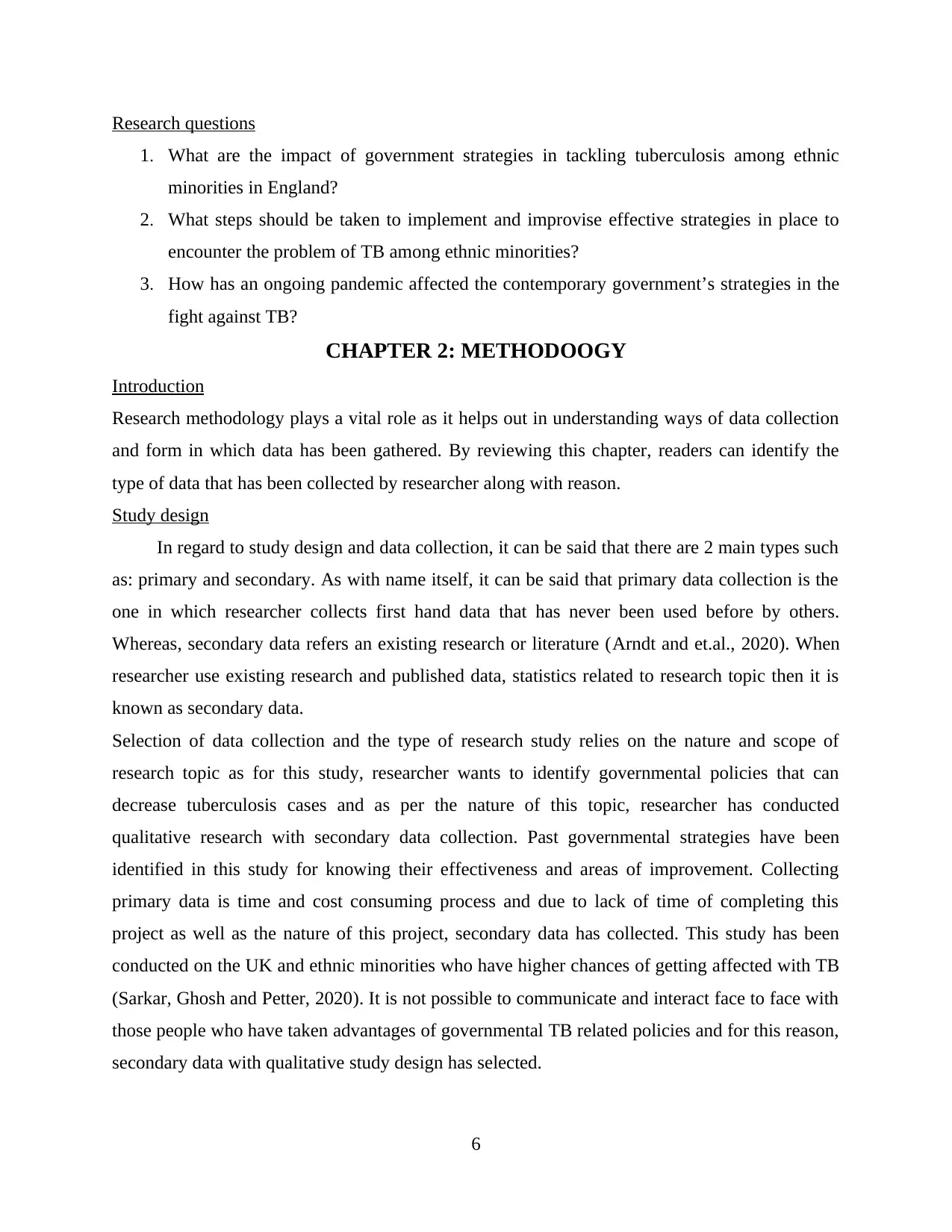
Research questions
1. What are the impact of government strategies in tackling tuberculosis among ethnic
minorities in England?
2. What steps should be taken to implement and improvise effective strategies in place to
encounter the problem of TB among ethnic minorities?
3. How has an ongoing pandemic affected the contemporary government’s strategies in the
fight against TB?
CHAPTER 2: METHODOOGY
Introduction
Research methodology plays a vital role as it helps out in understanding ways of data collection
and form in which data has been gathered. By reviewing this chapter, readers can identify the
type of data that has been collected by researcher along with reason.
Study design
In regard to study design and data collection, it can be said that there are 2 main types such
as: primary and secondary. As with name itself, it can be said that primary data collection is the
one in which researcher collects first hand data that has never been used before by others.
Whereas, secondary data refers an existing research or literature (Arndt and et.al., 2020). When
researcher use existing research and published data, statistics related to research topic then it is
known as secondary data.
Selection of data collection and the type of research study relies on the nature and scope of
research topic as for this study, researcher wants to identify governmental policies that can
decrease tuberculosis cases and as per the nature of this topic, researcher has conducted
qualitative research with secondary data collection. Past governmental strategies have been
identified in this study for knowing their effectiveness and areas of improvement. Collecting
primary data is time and cost consuming process and due to lack of time of completing this
project as well as the nature of this project, secondary data has collected. This study has been
conducted on the UK and ethnic minorities who have higher chances of getting affected with TB
(Sarkar, Ghosh and Petter, 2020). It is not possible to communicate and interact face to face with
those people who have taken advantages of governmental TB related policies and for this reason,
secondary data with qualitative study design has selected.
6
1. What are the impact of government strategies in tackling tuberculosis among ethnic
minorities in England?
2. What steps should be taken to implement and improvise effective strategies in place to
encounter the problem of TB among ethnic minorities?
3. How has an ongoing pandemic affected the contemporary government’s strategies in the
fight against TB?
CHAPTER 2: METHODOOGY
Introduction
Research methodology plays a vital role as it helps out in understanding ways of data collection
and form in which data has been gathered. By reviewing this chapter, readers can identify the
type of data that has been collected by researcher along with reason.
Study design
In regard to study design and data collection, it can be said that there are 2 main types such
as: primary and secondary. As with name itself, it can be said that primary data collection is the
one in which researcher collects first hand data that has never been used before by others.
Whereas, secondary data refers an existing research or literature (Arndt and et.al., 2020). When
researcher use existing research and published data, statistics related to research topic then it is
known as secondary data.
Selection of data collection and the type of research study relies on the nature and scope of
research topic as for this study, researcher wants to identify governmental policies that can
decrease tuberculosis cases and as per the nature of this topic, researcher has conducted
qualitative research with secondary data collection. Past governmental strategies have been
identified in this study for knowing their effectiveness and areas of improvement. Collecting
primary data is time and cost consuming process and due to lack of time of completing this
project as well as the nature of this project, secondary data has collected. This study has been
conducted on the UK and ethnic minorities who have higher chances of getting affected with TB
(Sarkar, Ghosh and Petter, 2020). It is not possible to communicate and interact face to face with
those people who have taken advantages of governmental TB related policies and for this reason,
secondary data with qualitative study design has selected.
6
⊘ This is a preview!⊘
Do you want full access?
Subscribe today to unlock all pages.

Trusted by 1+ million students worldwide
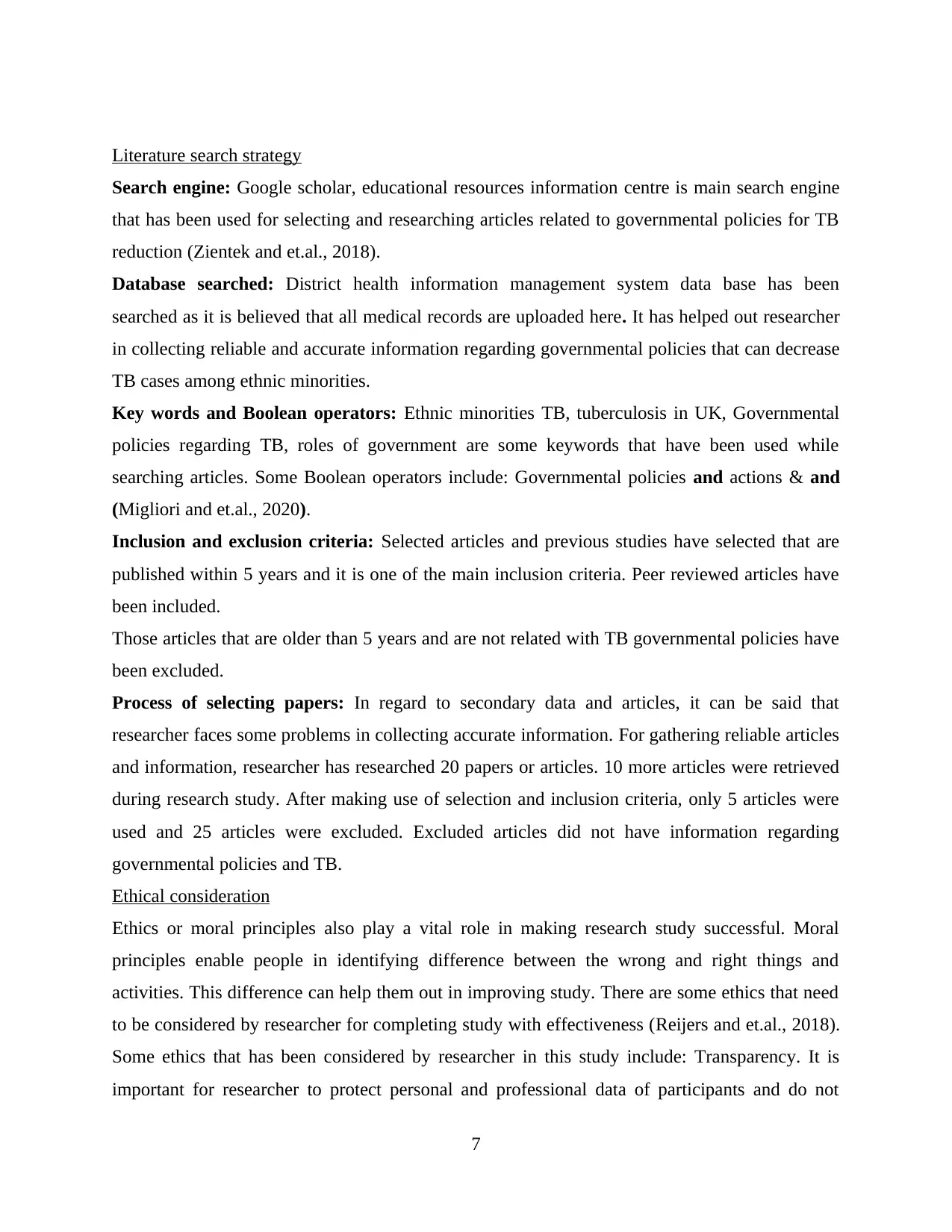
Literature search strategy
Search engine: Google scholar, educational resources information centre is main search engine
that has been used for selecting and researching articles related to governmental policies for TB
reduction (Zientek and et.al., 2018).
Database searched: District health information management system data base has been
searched as it is believed that all medical records are uploaded here. It has helped out researcher
in collecting reliable and accurate information regarding governmental policies that can decrease
TB cases among ethnic minorities.
Key words and Boolean operators: Ethnic minorities TB, tuberculosis in UK, Governmental
policies regarding TB, roles of government are some keywords that have been used while
searching articles. Some Boolean operators include: Governmental policies and actions & and
(Migliori and et.al., 2020).
Inclusion and exclusion criteria: Selected articles and previous studies have selected that are
published within 5 years and it is one of the main inclusion criteria. Peer reviewed articles have
been included.
Those articles that are older than 5 years and are not related with TB governmental policies have
been excluded.
Process of selecting papers: In regard to secondary data and articles, it can be said that
researcher faces some problems in collecting accurate information. For gathering reliable articles
and information, researcher has researched 20 papers or articles. 10 more articles were retrieved
during research study. After making use of selection and inclusion criteria, only 5 articles were
used and 25 articles were excluded. Excluded articles did not have information regarding
governmental policies and TB.
Ethical consideration
Ethics or moral principles also play a vital role in making research study successful. Moral
principles enable people in identifying difference between the wrong and right things and
activities. This difference can help them out in improving study. There are some ethics that need
to be considered by researcher for completing study with effectiveness (Reijers and et.al., 2018).
Some ethics that has been considered by researcher in this study include: Transparency. It is
important for researcher to protect personal and professional data of participants and do not
7
Search engine: Google scholar, educational resources information centre is main search engine
that has been used for selecting and researching articles related to governmental policies for TB
reduction (Zientek and et.al., 2018).
Database searched: District health information management system data base has been
searched as it is believed that all medical records are uploaded here. It has helped out researcher
in collecting reliable and accurate information regarding governmental policies that can decrease
TB cases among ethnic minorities.
Key words and Boolean operators: Ethnic minorities TB, tuberculosis in UK, Governmental
policies regarding TB, roles of government are some keywords that have been used while
searching articles. Some Boolean operators include: Governmental policies and actions & and
(Migliori and et.al., 2020).
Inclusion and exclusion criteria: Selected articles and previous studies have selected that are
published within 5 years and it is one of the main inclusion criteria. Peer reviewed articles have
been included.
Those articles that are older than 5 years and are not related with TB governmental policies have
been excluded.
Process of selecting papers: In regard to secondary data and articles, it can be said that
researcher faces some problems in collecting accurate information. For gathering reliable articles
and information, researcher has researched 20 papers or articles. 10 more articles were retrieved
during research study. After making use of selection and inclusion criteria, only 5 articles were
used and 25 articles were excluded. Excluded articles did not have information regarding
governmental policies and TB.
Ethical consideration
Ethics or moral principles also play a vital role in making research study successful. Moral
principles enable people in identifying difference between the wrong and right things and
activities. This difference can help them out in improving study. There are some ethics that need
to be considered by researcher for completing study with effectiveness (Reijers and et.al., 2018).
Some ethics that has been considered by researcher in this study include: Transparency. It is
important for researcher to protect personal and professional data of participants and do not
7
Paraphrase This Document
Need a fresh take? Get an instant paraphrase of this document with our AI Paraphraser
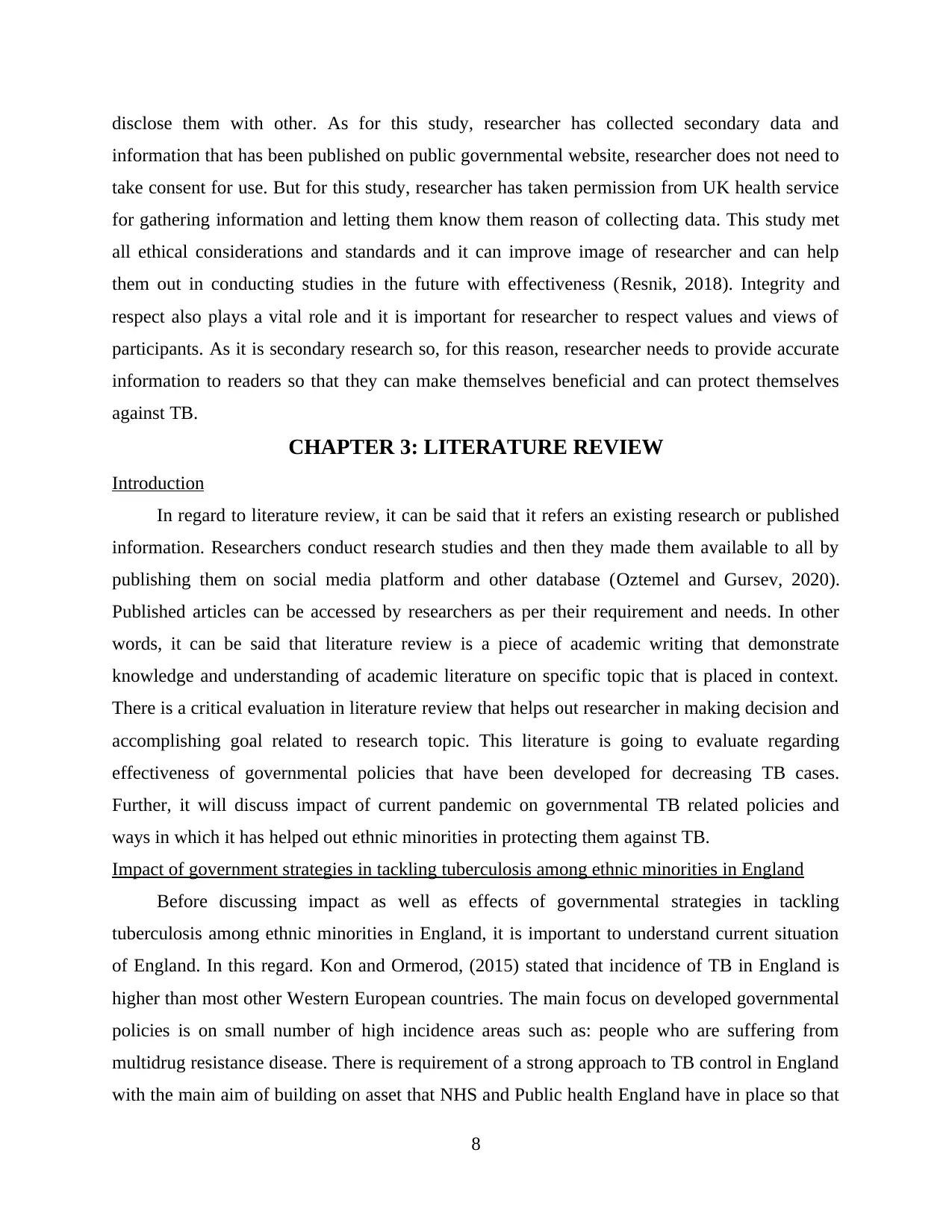
disclose them with other. As for this study, researcher has collected secondary data and
information that has been published on public governmental website, researcher does not need to
take consent for use. But for this study, researcher has taken permission from UK health service
for gathering information and letting them know them reason of collecting data. This study met
all ethical considerations and standards and it can improve image of researcher and can help
them out in conducting studies in the future with effectiveness (Resnik, 2018). Integrity and
respect also plays a vital role and it is important for researcher to respect values and views of
participants. As it is secondary research so, for this reason, researcher needs to provide accurate
information to readers so that they can make themselves beneficial and can protect themselves
against TB.
CHAPTER 3: LITERATURE REVIEW
Introduction
In regard to literature review, it can be said that it refers an existing research or published
information. Researchers conduct research studies and then they made them available to all by
publishing them on social media platform and other database (Oztemel and Gursev, 2020).
Published articles can be accessed by researchers as per their requirement and needs. In other
words, it can be said that literature review is a piece of academic writing that demonstrate
knowledge and understanding of academic literature on specific topic that is placed in context.
There is a critical evaluation in literature review that helps out researcher in making decision and
accomplishing goal related to research topic. This literature is going to evaluate regarding
effectiveness of governmental policies that have been developed for decreasing TB cases.
Further, it will discuss impact of current pandemic on governmental TB related policies and
ways in which it has helped out ethnic minorities in protecting them against TB.
Impact of government strategies in tackling tuberculosis among ethnic minorities in England
Before discussing impact as well as effects of governmental strategies in tackling
tuberculosis among ethnic minorities in England, it is important to understand current situation
of England. In this regard. Kon and Ormerod, (2015) stated that incidence of TB in England is
higher than most other Western European countries. The main focus on developed governmental
policies is on small number of high incidence areas such as: people who are suffering from
multidrug resistance disease. There is requirement of a strong approach to TB control in England
with the main aim of building on asset that NHS and Public health England have in place so that
8
information that has been published on public governmental website, researcher does not need to
take consent for use. But for this study, researcher has taken permission from UK health service
for gathering information and letting them know them reason of collecting data. This study met
all ethical considerations and standards and it can improve image of researcher and can help
them out in conducting studies in the future with effectiveness (Resnik, 2018). Integrity and
respect also plays a vital role and it is important for researcher to respect values and views of
participants. As it is secondary research so, for this reason, researcher needs to provide accurate
information to readers so that they can make themselves beneficial and can protect themselves
against TB.
CHAPTER 3: LITERATURE REVIEW
Introduction
In regard to literature review, it can be said that it refers an existing research or published
information. Researchers conduct research studies and then they made them available to all by
publishing them on social media platform and other database (Oztemel and Gursev, 2020).
Published articles can be accessed by researchers as per their requirement and needs. In other
words, it can be said that literature review is a piece of academic writing that demonstrate
knowledge and understanding of academic literature on specific topic that is placed in context.
There is a critical evaluation in literature review that helps out researcher in making decision and
accomplishing goal related to research topic. This literature is going to evaluate regarding
effectiveness of governmental policies that have been developed for decreasing TB cases.
Further, it will discuss impact of current pandemic on governmental TB related policies and
ways in which it has helped out ethnic minorities in protecting them against TB.
Impact of government strategies in tackling tuberculosis among ethnic minorities in England
Before discussing impact as well as effects of governmental strategies in tackling
tuberculosis among ethnic minorities in England, it is important to understand current situation
of England. In this regard. Kon and Ormerod, (2015) stated that incidence of TB in England is
higher than most other Western European countries. The main focus on developed governmental
policies is on small number of high incidence areas such as: people who are suffering from
multidrug resistance disease. There is requirement of a strong approach to TB control in England
with the main aim of building on asset that NHS and Public health England have in place so that
8
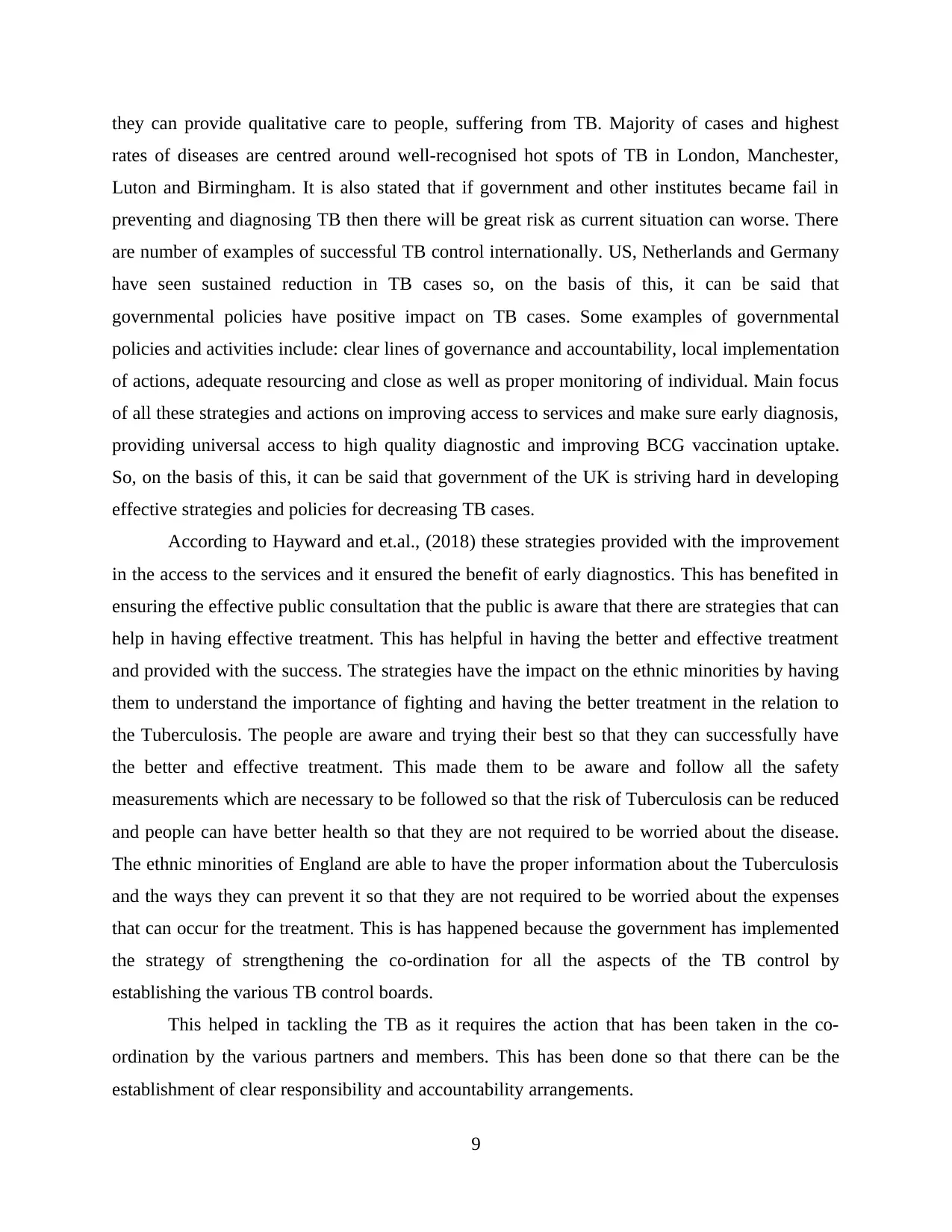
they can provide qualitative care to people, suffering from TB. Majority of cases and highest
rates of diseases are centred around well-recognised hot spots of TB in London, Manchester,
Luton and Birmingham. It is also stated that if government and other institutes became fail in
preventing and diagnosing TB then there will be great risk as current situation can worse. There
are number of examples of successful TB control internationally. US, Netherlands and Germany
have seen sustained reduction in TB cases so, on the basis of this, it can be said that
governmental policies have positive impact on TB cases. Some examples of governmental
policies and activities include: clear lines of governance and accountability, local implementation
of actions, adequate resourcing and close as well as proper monitoring of individual. Main focus
of all these strategies and actions on improving access to services and make sure early diagnosis,
providing universal access to high quality diagnostic and improving BCG vaccination uptake.
So, on the basis of this, it can be said that government of the UK is striving hard in developing
effective strategies and policies for decreasing TB cases.
According to Hayward and et.al., (2018) these strategies provided with the improvement
in the access to the services and it ensured the benefit of early diagnostics. This has benefited in
ensuring the effective public consultation that the public is aware that there are strategies that can
help in having effective treatment. This has helpful in having the better and effective treatment
and provided with the success. The strategies have the impact on the ethnic minorities by having
them to understand the importance of fighting and having the better treatment in the relation to
the Tuberculosis. The people are aware and trying their best so that they can successfully have
the better and effective treatment. This made them to be aware and follow all the safety
measurements which are necessary to be followed so that the risk of Tuberculosis can be reduced
and people can have better health so that they are not required to be worried about the disease.
The ethnic minorities of England are able to have the proper information about the Tuberculosis
and the ways they can prevent it so that they are not required to be worried about the expenses
that can occur for the treatment. This is has happened because the government has implemented
the strategy of strengthening the co-ordination for all the aspects of the TB control by
establishing the various TB control boards.
This helped in tackling the TB as it requires the action that has been taken in the co-
ordination by the various partners and members. This has been done so that there can be the
establishment of clear responsibility and accountability arrangements.
9
rates of diseases are centred around well-recognised hot spots of TB in London, Manchester,
Luton and Birmingham. It is also stated that if government and other institutes became fail in
preventing and diagnosing TB then there will be great risk as current situation can worse. There
are number of examples of successful TB control internationally. US, Netherlands and Germany
have seen sustained reduction in TB cases so, on the basis of this, it can be said that
governmental policies have positive impact on TB cases. Some examples of governmental
policies and activities include: clear lines of governance and accountability, local implementation
of actions, adequate resourcing and close as well as proper monitoring of individual. Main focus
of all these strategies and actions on improving access to services and make sure early diagnosis,
providing universal access to high quality diagnostic and improving BCG vaccination uptake.
So, on the basis of this, it can be said that government of the UK is striving hard in developing
effective strategies and policies for decreasing TB cases.
According to Hayward and et.al., (2018) these strategies provided with the improvement
in the access to the services and it ensured the benefit of early diagnostics. This has benefited in
ensuring the effective public consultation that the public is aware that there are strategies that can
help in having effective treatment. This has helpful in having the better and effective treatment
and provided with the success. The strategies have the impact on the ethnic minorities by having
them to understand the importance of fighting and having the better treatment in the relation to
the Tuberculosis. The people are aware and trying their best so that they can successfully have
the better and effective treatment. This made them to be aware and follow all the safety
measurements which are necessary to be followed so that the risk of Tuberculosis can be reduced
and people can have better health so that they are not required to be worried about the disease.
The ethnic minorities of England are able to have the proper information about the Tuberculosis
and the ways they can prevent it so that they are not required to be worried about the expenses
that can occur for the treatment. This is has happened because the government has implemented
the strategy of strengthening the co-ordination for all the aspects of the TB control by
establishing the various TB control boards.
This helped in tackling the TB as it requires the action that has been taken in the co-
ordination by the various partners and members. This has been done so that there can be the
establishment of clear responsibility and accountability arrangements.
9
⊘ This is a preview!⊘
Do you want full access?
Subscribe today to unlock all pages.

Trusted by 1+ million students worldwide
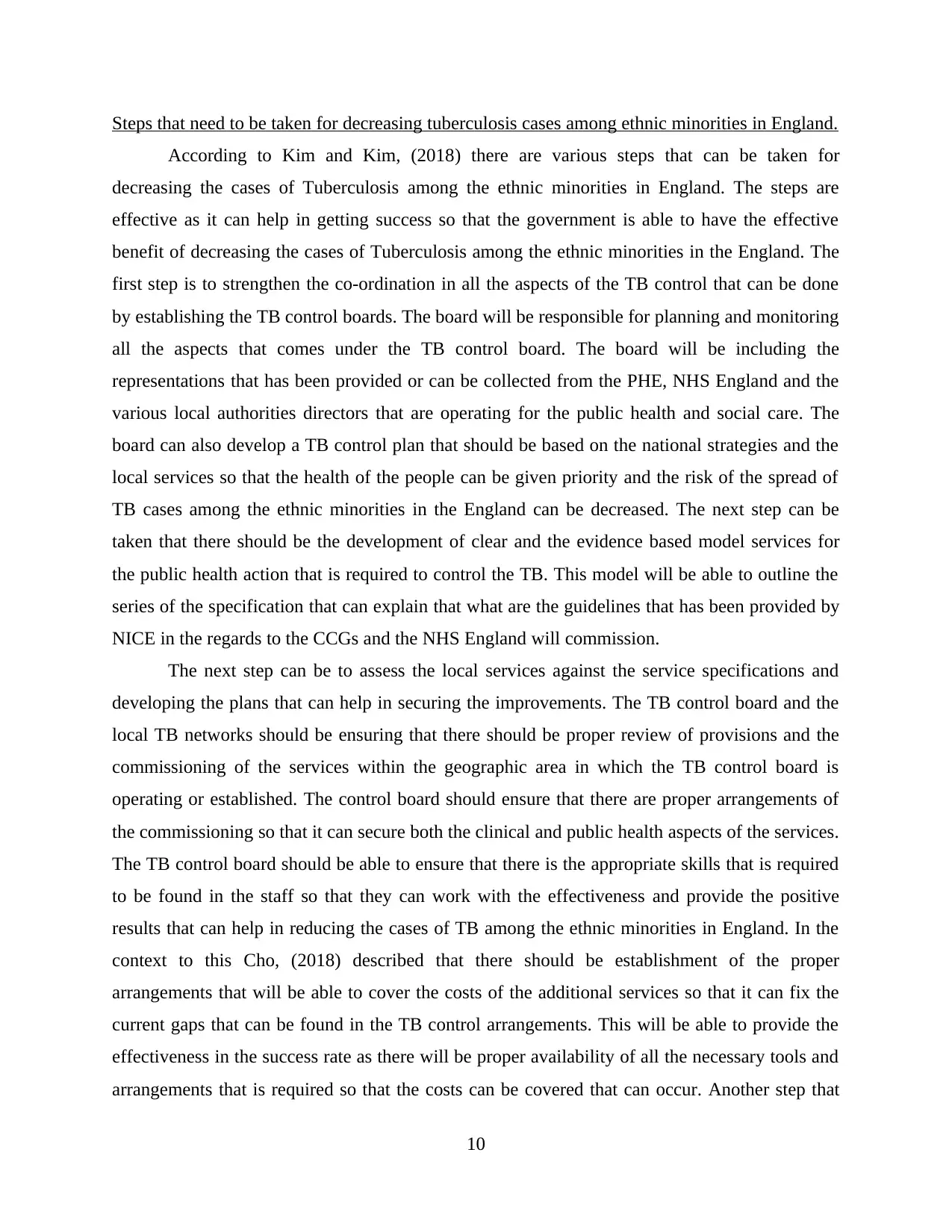
Steps that need to be taken for decreasing tuberculosis cases among ethnic minorities in England.
According to Kim and Kim, (2018) there are various steps that can be taken for
decreasing the cases of Tuberculosis among the ethnic minorities in England. The steps are
effective as it can help in getting success so that the government is able to have the effective
benefit of decreasing the cases of Tuberculosis among the ethnic minorities in the England. The
first step is to strengthen the co-ordination in all the aspects of the TB control that can be done
by establishing the TB control boards. The board will be responsible for planning and monitoring
all the aspects that comes under the TB control board. The board will be including the
representations that has been provided or can be collected from the PHE, NHS England and the
various local authorities directors that are operating for the public health and social care. The
board can also develop a TB control plan that should be based on the national strategies and the
local services so that the health of the people can be given priority and the risk of the spread of
TB cases among the ethnic minorities in the England can be decreased. The next step can be
taken that there should be the development of clear and the evidence based model services for
the public health action that is required to control the TB. This model will be able to outline the
series of the specification that can explain that what are the guidelines that has been provided by
NICE in the regards to the CCGs and the NHS England will commission.
The next step can be to assess the local services against the service specifications and
developing the plans that can help in securing the improvements. The TB control board and the
local TB networks should be ensuring that there should be proper review of provisions and the
commissioning of the services within the geographic area in which the TB control board is
operating or established. The control board should ensure that there are proper arrangements of
the commissioning so that it can secure both the clinical and public health aspects of the services.
The TB control board should be able to ensure that there is the appropriate skills that is required
to be found in the staff so that they can work with the effectiveness and provide the positive
results that can help in reducing the cases of TB among the ethnic minorities in England. In the
context to this Cho, (2018) described that there should be establishment of the proper
arrangements that will be able to cover the costs of the additional services so that it can fix the
current gaps that can be found in the TB control arrangements. This will be able to provide the
effectiveness in the success rate as there will be proper availability of all the necessary tools and
arrangements that is required so that the costs can be covered that can occur. Another step that
10
According to Kim and Kim, (2018) there are various steps that can be taken for
decreasing the cases of Tuberculosis among the ethnic minorities in England. The steps are
effective as it can help in getting success so that the government is able to have the effective
benefit of decreasing the cases of Tuberculosis among the ethnic minorities in the England. The
first step is to strengthen the co-ordination in all the aspects of the TB control that can be done
by establishing the TB control boards. The board will be responsible for planning and monitoring
all the aspects that comes under the TB control board. The board will be including the
representations that has been provided or can be collected from the PHE, NHS England and the
various local authorities directors that are operating for the public health and social care. The
board can also develop a TB control plan that should be based on the national strategies and the
local services so that the health of the people can be given priority and the risk of the spread of
TB cases among the ethnic minorities in the England can be decreased. The next step can be
taken that there should be the development of clear and the evidence based model services for
the public health action that is required to control the TB. This model will be able to outline the
series of the specification that can explain that what are the guidelines that has been provided by
NICE in the regards to the CCGs and the NHS England will commission.
The next step can be to assess the local services against the service specifications and
developing the plans that can help in securing the improvements. The TB control board and the
local TB networks should be ensuring that there should be proper review of provisions and the
commissioning of the services within the geographic area in which the TB control board is
operating or established. The control board should ensure that there are proper arrangements of
the commissioning so that it can secure both the clinical and public health aspects of the services.
The TB control board should be able to ensure that there is the appropriate skills that is required
to be found in the staff so that they can work with the effectiveness and provide the positive
results that can help in reducing the cases of TB among the ethnic minorities in England. In the
context to this Cho, (2018) described that there should be establishment of the proper
arrangements that will be able to cover the costs of the additional services so that it can fix the
current gaps that can be found in the TB control arrangements. This will be able to provide the
effectiveness in the success rate as there will be proper availability of all the necessary tools and
arrangements that is required so that the costs can be covered that can occur. Another step that
10
Paraphrase This Document
Need a fresh take? Get an instant paraphrase of this document with our AI Paraphraser
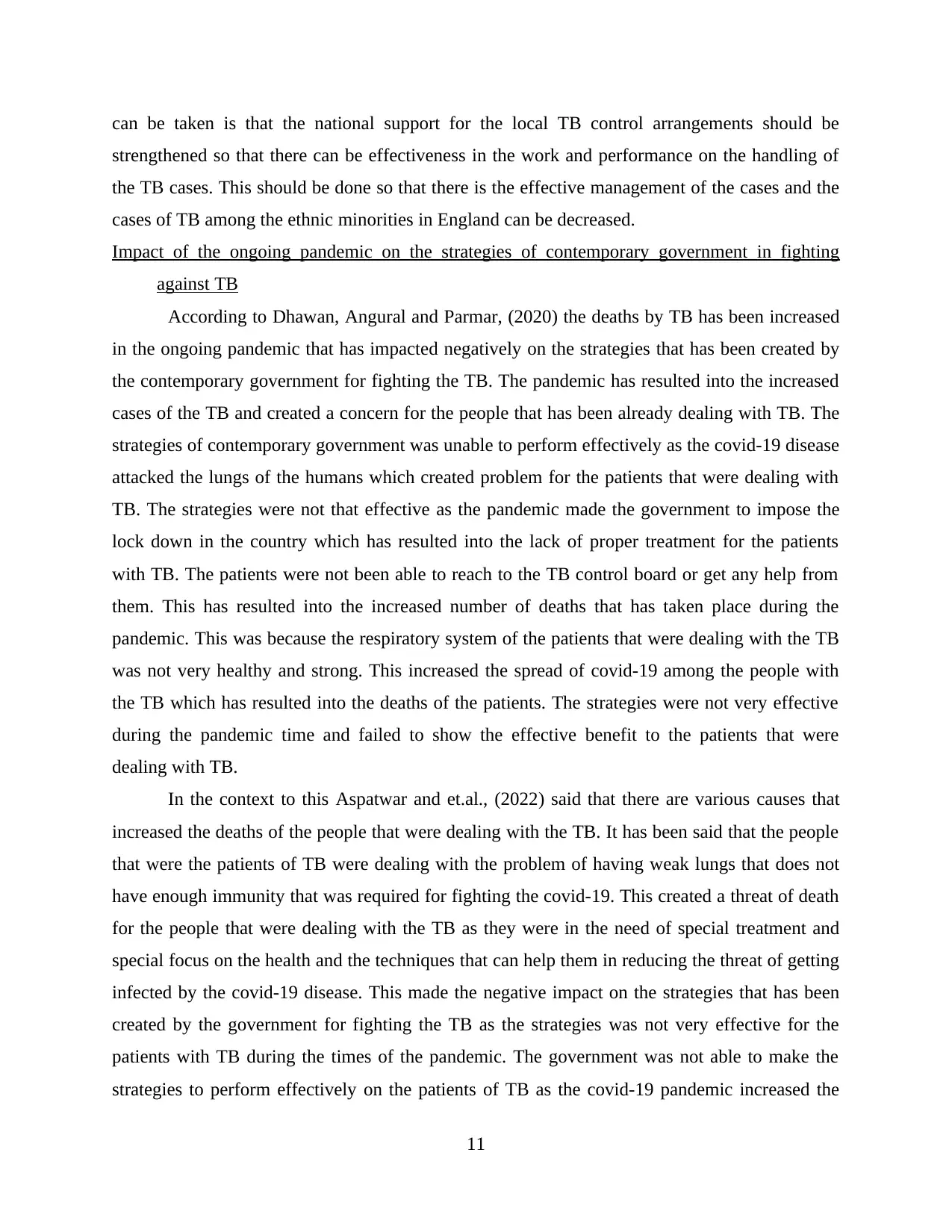
can be taken is that the national support for the local TB control arrangements should be
strengthened so that there can be effectiveness in the work and performance on the handling of
the TB cases. This should be done so that there is the effective management of the cases and the
cases of TB among the ethnic minorities in England can be decreased.
Impact of the ongoing pandemic on the strategies of contemporary government in fighting
against TB
According to Dhawan, Angural and Parmar, (2020) the deaths by TB has been increased
in the ongoing pandemic that has impacted negatively on the strategies that has been created by
the contemporary government for fighting the TB. The pandemic has resulted into the increased
cases of the TB and created a concern for the people that has been already dealing with TB. The
strategies of contemporary government was unable to perform effectively as the covid-19 disease
attacked the lungs of the humans which created problem for the patients that were dealing with
TB. The strategies were not that effective as the pandemic made the government to impose the
lock down in the country which has resulted into the lack of proper treatment for the patients
with TB. The patients were not been able to reach to the TB control board or get any help from
them. This has resulted into the increased number of deaths that has taken place during the
pandemic. This was because the respiratory system of the patients that were dealing with the TB
was not very healthy and strong. This increased the spread of covid-19 among the people with
the TB which has resulted into the deaths of the patients. The strategies were not very effective
during the pandemic time and failed to show the effective benefit to the patients that were
dealing with TB.
In the context to this Aspatwar and et.al., (2022) said that there are various causes that
increased the deaths of the people that were dealing with the TB. It has been said that the people
that were the patients of TB were dealing with the problem of having weak lungs that does not
have enough immunity that was required for fighting the covid-19. This created a threat of death
for the people that were dealing with the TB as they were in the need of special treatment and
special focus on the health and the techniques that can help them in reducing the threat of getting
infected by the covid-19 disease. This made the negative impact on the strategies that has been
created by the government for fighting the TB as the strategies was not very effective for the
patients with TB during the times of the pandemic. The government was not able to make the
strategies to perform effectively on the patients of TB as the covid-19 pandemic increased the
11
strengthened so that there can be effectiveness in the work and performance on the handling of
the TB cases. This should be done so that there is the effective management of the cases and the
cases of TB among the ethnic minorities in England can be decreased.
Impact of the ongoing pandemic on the strategies of contemporary government in fighting
against TB
According to Dhawan, Angural and Parmar, (2020) the deaths by TB has been increased
in the ongoing pandemic that has impacted negatively on the strategies that has been created by
the contemporary government for fighting the TB. The pandemic has resulted into the increased
cases of the TB and created a concern for the people that has been already dealing with TB. The
strategies of contemporary government was unable to perform effectively as the covid-19 disease
attacked the lungs of the humans which created problem for the patients that were dealing with
TB. The strategies were not that effective as the pandemic made the government to impose the
lock down in the country which has resulted into the lack of proper treatment for the patients
with TB. The patients were not been able to reach to the TB control board or get any help from
them. This has resulted into the increased number of deaths that has taken place during the
pandemic. This was because the respiratory system of the patients that were dealing with the TB
was not very healthy and strong. This increased the spread of covid-19 among the people with
the TB which has resulted into the deaths of the patients. The strategies were not very effective
during the pandemic time and failed to show the effective benefit to the patients that were
dealing with TB.
In the context to this Aspatwar and et.al., (2022) said that there are various causes that
increased the deaths of the people that were dealing with the TB. It has been said that the people
that were the patients of TB were dealing with the problem of having weak lungs that does not
have enough immunity that was required for fighting the covid-19. This created a threat of death
for the people that were dealing with the TB as they were in the need of special treatment and
special focus on the health and the techniques that can help them in reducing the threat of getting
infected by the covid-19 disease. This made the negative impact on the strategies that has been
created by the government for fighting the TB as the strategies was not very effective for the
patients with TB during the times of the pandemic. The government was not able to make the
strategies to perform effectively on the patients of TB as the covid-19 pandemic increased the
11
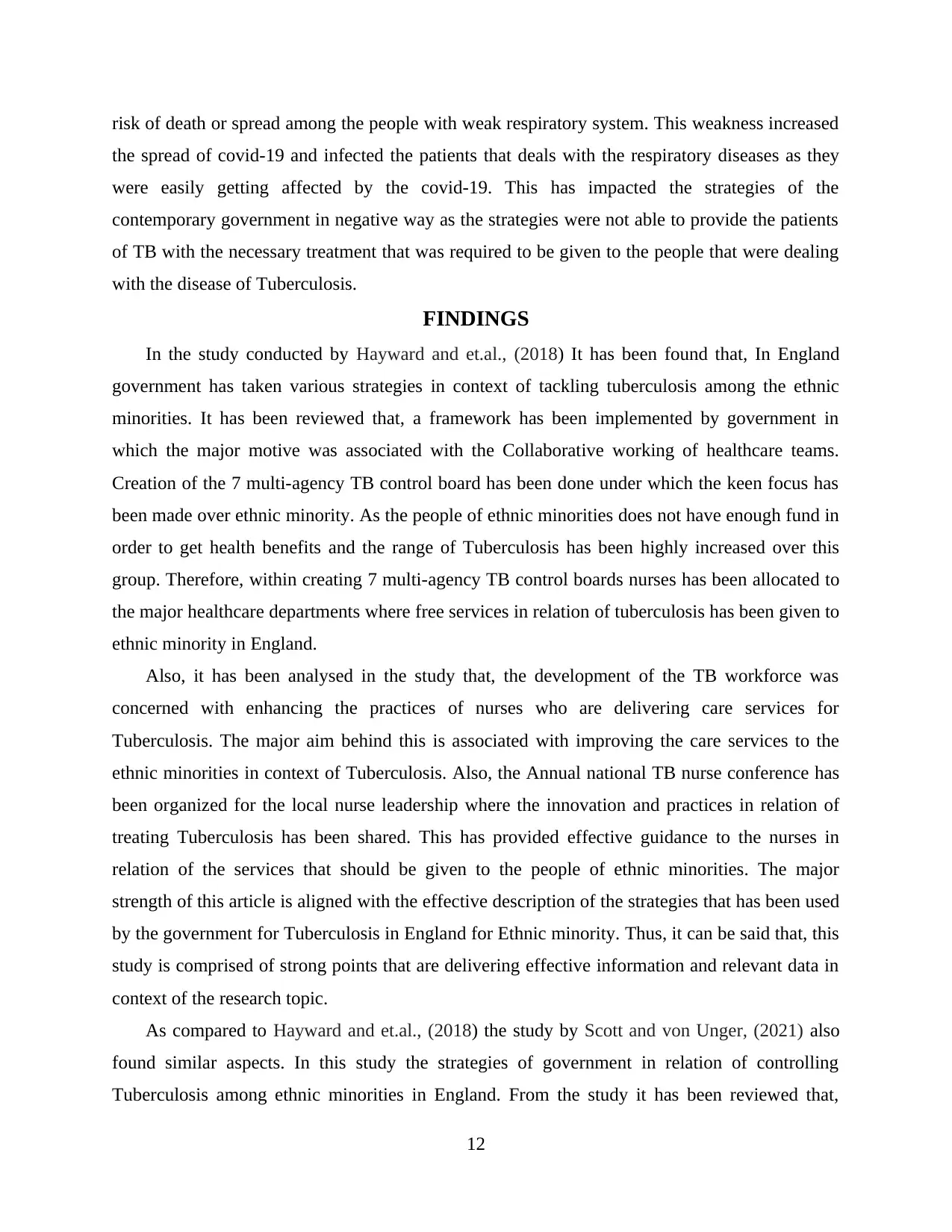
risk of death or spread among the people with weak respiratory system. This weakness increased
the spread of covid-19 and infected the patients that deals with the respiratory diseases as they
were easily getting affected by the covid-19. This has impacted the strategies of the
contemporary government in negative way as the strategies were not able to provide the patients
of TB with the necessary treatment that was required to be given to the people that were dealing
with the disease of Tuberculosis.
FINDINGS
In the study conducted by Hayward and et.al., (2018) It has been found that, In England
government has taken various strategies in context of tackling tuberculosis among the ethnic
minorities. It has been reviewed that, a framework has been implemented by government in
which the major motive was associated with the Collaborative working of healthcare teams.
Creation of the 7 multi-agency TB control board has been done under which the keen focus has
been made over ethnic minority. As the people of ethnic minorities does not have enough fund in
order to get health benefits and the range of Tuberculosis has been highly increased over this
group. Therefore, within creating 7 multi-agency TB control boards nurses has been allocated to
the major healthcare departments where free services in relation of tuberculosis has been given to
ethnic minority in England.
Also, it has been analysed in the study that, the development of the TB workforce was
concerned with enhancing the practices of nurses who are delivering care services for
Tuberculosis. The major aim behind this is associated with improving the care services to the
ethnic minorities in context of Tuberculosis. Also, the Annual national TB nurse conference has
been organized for the local nurse leadership where the innovation and practices in relation of
treating Tuberculosis has been shared. This has provided effective guidance to the nurses in
relation of the services that should be given to the people of ethnic minorities. The major
strength of this article is aligned with the effective description of the strategies that has been used
by the government for Tuberculosis in England for Ethnic minority. Thus, it can be said that, this
study is comprised of strong points that are delivering effective information and relevant data in
context of the research topic.
As compared to Hayward and et.al., (2018) the study by Scott and von Unger, (2021) also
found similar aspects. In this study the strategies of government in relation of controlling
Tuberculosis among ethnic minorities in England. From the study it has been reviewed that,
12
the spread of covid-19 and infected the patients that deals with the respiratory diseases as they
were easily getting affected by the covid-19. This has impacted the strategies of the
contemporary government in negative way as the strategies were not able to provide the patients
of TB with the necessary treatment that was required to be given to the people that were dealing
with the disease of Tuberculosis.
FINDINGS
In the study conducted by Hayward and et.al., (2018) It has been found that, In England
government has taken various strategies in context of tackling tuberculosis among the ethnic
minorities. It has been reviewed that, a framework has been implemented by government in
which the major motive was associated with the Collaborative working of healthcare teams.
Creation of the 7 multi-agency TB control board has been done under which the keen focus has
been made over ethnic minority. As the people of ethnic minorities does not have enough fund in
order to get health benefits and the range of Tuberculosis has been highly increased over this
group. Therefore, within creating 7 multi-agency TB control boards nurses has been allocated to
the major healthcare departments where free services in relation of tuberculosis has been given to
ethnic minority in England.
Also, it has been analysed in the study that, the development of the TB workforce was
concerned with enhancing the practices of nurses who are delivering care services for
Tuberculosis. The major aim behind this is associated with improving the care services to the
ethnic minorities in context of Tuberculosis. Also, the Annual national TB nurse conference has
been organized for the local nurse leadership where the innovation and practices in relation of
treating Tuberculosis has been shared. This has provided effective guidance to the nurses in
relation of the services that should be given to the people of ethnic minorities. The major
strength of this article is aligned with the effective description of the strategies that has been used
by the government for Tuberculosis in England for Ethnic minority. Thus, it can be said that, this
study is comprised of strong points that are delivering effective information and relevant data in
context of the research topic.
As compared to Hayward and et.al., (2018) the study by Scott and von Unger, (2021) also
found similar aspects. In this study the strategies of government in relation of controlling
Tuberculosis among ethnic minorities in England. From the study it has been reviewed that,
12
⊘ This is a preview!⊘
Do you want full access?
Subscribe today to unlock all pages.

Trusted by 1+ million students worldwide
1 out of 24
Related Documents
Your All-in-One AI-Powered Toolkit for Academic Success.
+13062052269
info@desklib.com
Available 24*7 on WhatsApp / Email
![[object Object]](/_next/static/media/star-bottom.7253800d.svg)
Unlock your academic potential
Copyright © 2020–2025 A2Z Services. All Rights Reserved. Developed and managed by ZUCOL.




![Tuberculosis: A Global Health Problem Report - [University Name]](/_next/image/?url=https%3A%2F%2Fdesklib.com%2Fmedia%2Fimages%2Frm%2F9203536188144271bb8888f35ea5092d.jpg&w=256&q=75)
